2019 Bentley Continental GT: Going Ballistic

Tradition runs deep at Bentley, as was eminently clear when the company pulled back the curtain on the third-generation Continental GT at its headquarters in Crewe, England. Parked near the lone preproduction 2019 GT was a voluptuous 1953 Bentley R-type Continental coupe, which was the fastest four-seat car in the world in its day.
As the execs on hand pointed out, everything from the elegant sweep of the R-type’s fenders to its buttoned-down high-speed demeanor inspired the original 2004 Continental GT and its nearly identical-looking 2012 successor. So, too, this newest GT, which looks so much like the previous two models you could be forgiven for thinking it’s a mere facelift.
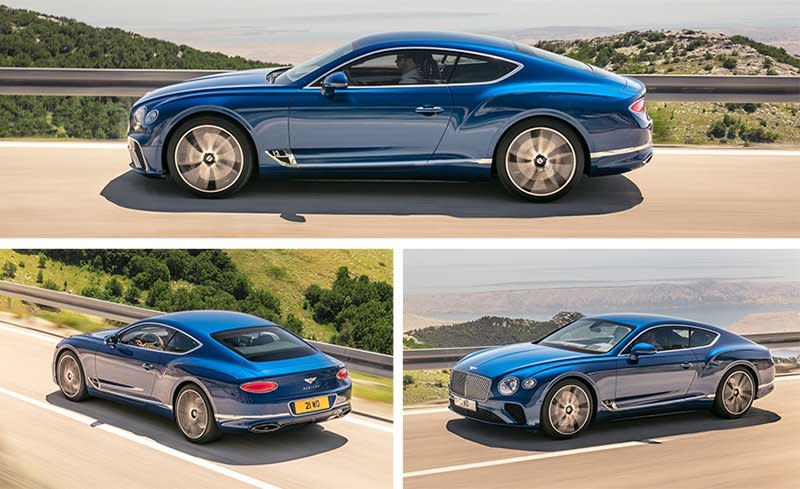
It’s not. Bentley design may evolve at glacial speed, but the GT’s mostly aluminum skin, as well as just about everything else down to the bottom of its tire treads, is completely new.
In a reversal of the normal timeline for new-car launches, we’ve already gotten a sense for how the new GT will drive from time spent with the Bentley engineering development team during cold-weather testing of GT prototypes. The event in Crewe was an opportunity for company leadership to fill in the technical details on how they attacked their objective of building “the best grand-touring car in the world.”
In pursuit of that lofty goal, Bentley based the 2019 Continental GT on the same architecture that underpins the latest Porsche Panamera: parent company Volkswagen’s corporate MSB architecture. Some 83 percent of those parts have been modified for use in the Conti coupe, however. The mass-efficient MSB platform contributes to a claimed overall weight savings of between 220 and 286 pounds over the old model, depending upon equipment. At about 5000 pounds, though, the new GT still is no lightweight.
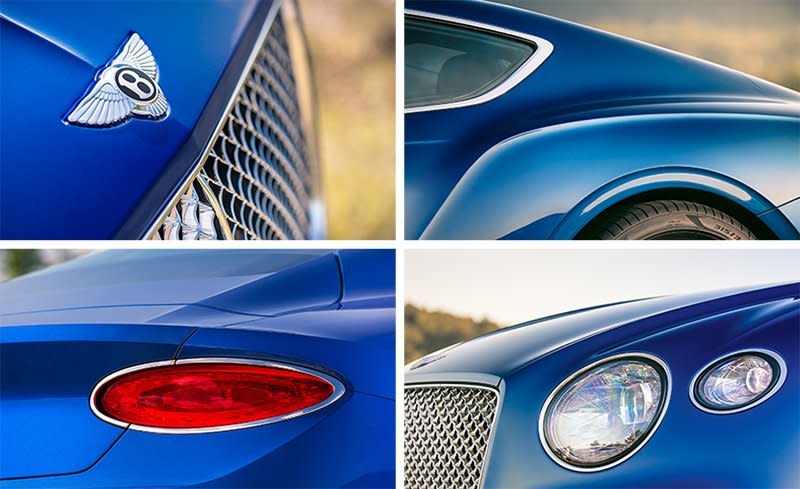
The 2019 Continental is marginally larger than before—about a half-inch wider and that much lower but no longer. The biggest dimensional difference is that it rides on a 4.1-inch-longer wheelbase and that the MSB underpinnings push the front wheels 4.3 inches farther forward relative to the base of the windshield, reducing the percentage of weight on the nose from 58 to 55 percent, says Bentley.
We wriggled into one of the lushly appointed rear buckets and found it can accommodate a six-footer, but for those long drives to grandmother’s estate you’ll still want to take the bigger Mulsanne. To keep the GT’s cabin as peaceful as possible, acoustic-laminated glass is used in all but the rear window; it reportedly reduces the noise of passing vehicles by an impressive nine decibels. Underbody acoustical panels have been added to silence road noise, and the tires are fitted with special sound-absorbing liners to further diminish road ruckus.
Fancy New Suspenders
Bentley wanted the new GT’s handling to be sportier and more responsive without giving up ride quality, so the new one adopts similar chassis technology to the Panamera: control arms at the front and a multilink setup at the rear, with four-corner, triple-chamber air springs; adaptive dampers; and active anti-roll bars at the front and rear. The system, called Bentley Dynamic Ride, also seen on the Bentayga SUV, continuously adjusts spring rates, shock damping, anti-roll-bar stiffness, and ride height to balance ride, handling, and front-to-rear grip. There are four driving modes: Comfort, Sport, Custom, and Bentley—the last being the ride-and-handling combination favored by Crewe’s engineers.
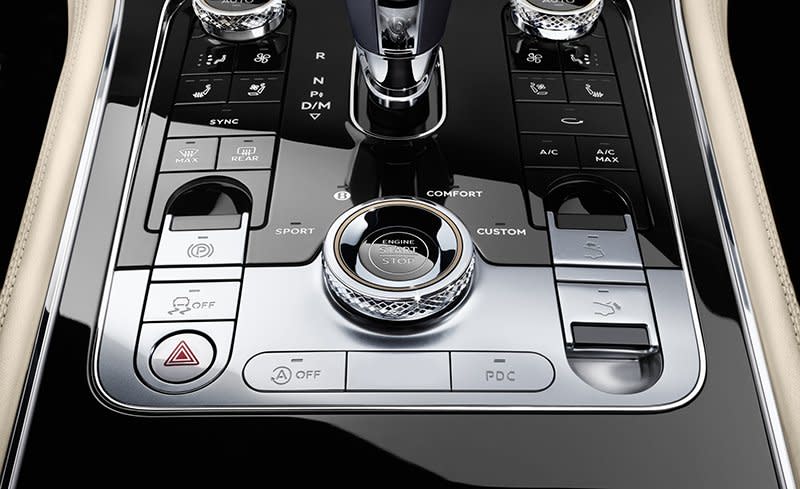
The GT’s standard powerplant is again a silken twin-turbo W-12, this one based on the all-new version first seen in the Bentayga. It utilizes both direct and port fuel injection, a pair of twin-scroll turbochargers, cylinder deactivation, variable valve lift, and auto stop/start. The 12-cylinder develops 626 horsepower at 6000 rpm—an increase of 26 horses over the Bentayga’s mill. Torque is rated at 664 lb-ft at 1350 rpm, which matches that of the Bentayga and remains flat to 4500 rpm. On the off chance that anyone buying a $200,000-plus chariot cares, fuel efficiency is said to be improved by 16 percent.
The W-12 sends its torque to an eight-speed dual-clutch automatic—a version of the Panamera’s ZF-supplied unit—rather than the former eight-speed torque-converter transmission. Bentley says the DCT’s quicker shifts plus the ability to crank up shift firmness in Sport mode enhances the sporty feel of the car. There’s even a launch-control feature, which should make for quite a show at stoplights.
The engine’s prodigious torque is funneled to the GT’s Pirelli P Zero tires—265/40ZR-21 fronts, 305/35ZR-21 rears—through a new all-wheel-drive system that directs 100 percent of the torque to the rear wheels in most driving situations. Its electronically controlled center coupler can shift up to 38 percent of the available torque to the front wheels when rear tire slip is detected, or when the Dynamic Ride system determines that it will mitigate under- or oversteer, or to help the big coupe rotate in corners. Brake-based torque vectoring is used to fine-tune traction at each tire patch.
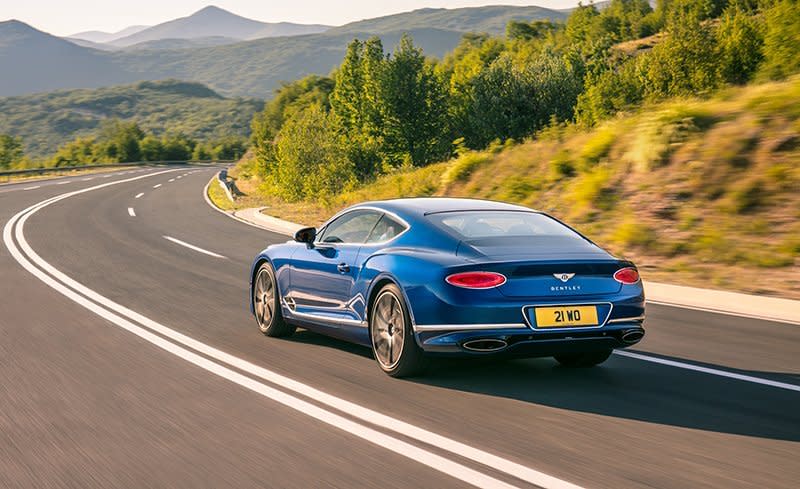
Going Ballistic
Big horsepower and all-wheel-drive traction add up to mega performance. Bentley is claiming a zero-to-60-mph time of 3.6 seconds and a top speed of 207 mph for this version of the Continental GT. However, we’ve already clocked the roughly 500-pound-heavier Bentayga at an astonishing 3.5 seconds to 60 mph, so the GT likely will be even quicker. Stopping the massive coupe are a set of bigger brakes: huge 16.5-inch front rotors and 10-piston front calipers plus 15.0-inch rear rotors clamped by four-piston calipers.
Not surprisingly, the new Conti will offer a comprehensive array of active-safety tech, including semi-autonomous steering capability. One safety feature you won’t find on other cars: a smart LED headlight array that can split its beam down the center and direct it around oncoming cars—and also those you are overtaking—so that the ultrabright lighting doesn’t blind other drivers. (Bentley representatives say that U.S.-spec cars will have these headlights.)
As impressive as the GT’s long list of technology is, much of it is available on far less costly automobiles. What separates a Bentley from the mass-produced, proletarian hordes is presentation. A Continental GT wouldn’t be worth the winged-B badge on the hood if its design, interior materials, and craftsmanship didn’t leave you gobsmacked. Judging by the preproduction GT on display in Crewe, the new car does not disappoint.
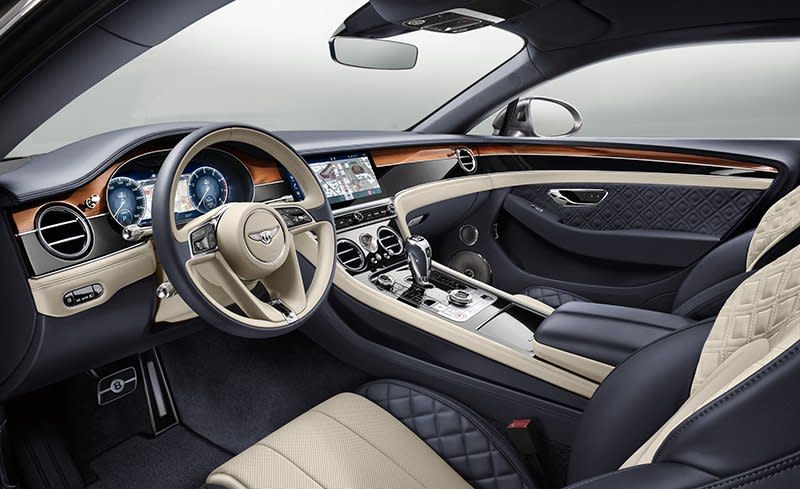
Experience with other Bentley products has us feeling confident that the prototype GT’s stellar exterior build quality and flawless paint will carry through to production. Like previous Bentleys, the new GT’s interior is stunning. It is here, more than anywhere else, that the Continental GT stakes out its membership in the same class of luxury goods as Patek Philippe, Brioni, and Hermès.
Eight gorgeous wood veneers are available for accenting the cabin. What’s not covered in wood or polished metal is swathed in sumptuous leather—nine Northern European bull hides per car, stitched together without so much as a wrinkle, every seam meticulously aligned. Those hides feel like they were rubbed with butter, and their aroma is so intoxicating it should be regulated by the DEA. For the GT’s optional center-console trim, the interior design team adapted the Côtes de Genève metal finish used inside high-end watches like Breitlings and Chopards. Of course, GT occupants’ ears are treated equally well: Sound systems range from a base 650-watt, 10-speaker setup to a Naim 2200-watt, 18-speaker audiophile’s dream.
Watch This
The GT interior’s party trick is its optional Bentley Rotating Display. Located where the standard car’s 12.3-inch infotainment touchscreen usually resides, it’s composed of three panels on a complex internal rotisserie that flips like James Bond’s trick license plate. A touch of a button fills the center of the dash with either a slab of matching veneer, a 12.3-inch touchscreen, or a set of three classic-looking round analog gauges: a compass, a timer, and an outside-air-temperature gauge.
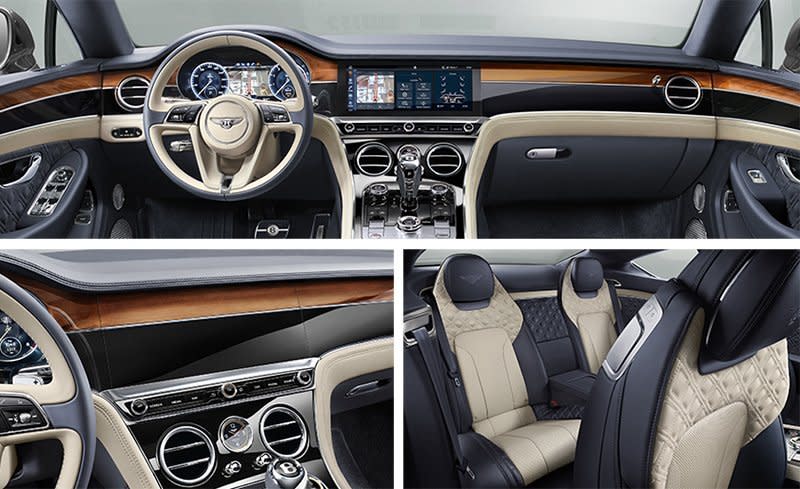
Beyond the trick display, the Continental GT offers several option packages. The base 12-way front buckets can be upgraded to thrones with 20-way adjustability and massage. Two active-safety groups, dubbed City Specification and Touring Specification, add everything from adaptive cruise to automated emergency braking—although the GT offers no safety tech you couldn’t order on most family sedans. A Mulliner Driving Specification package ups wheel size from 21 to 22 inches and enhances the cabin with special quilted leather and several personalized trim pieces. And if an off-the-rack Continental GT is just too common, you can commission a bespoke model through the firm’s Mulliner customization division. They will be more than happy to oblige almost every whim.
Bentley was mum on the subject of both pricing and future variants, although the company didn’t deny that the new model lineup ultimately will expand to be similar to today’s. The next, grandest generation of opulent grand touring goes on sale in America in mid-2018, and we expect Bentley customers will find the new Continental GT as tasty as the best Dom Pérignon in their wine cellar.

